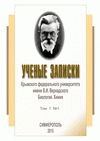A comparative evaluation of the effectiveness of various detecting reagents was carried out in terms of detection limit and differences in the coloration of chromatographic zones for different triterpenoid series. It was shown that the most effective detecting reagents are those based on phosphotungstic acid with the addition of aromatic aldehydes (para-hydroxybenzaldehyde and vanillin) and sulfuric acid. It was demonstrated that the spots of glycosides from the β-amyrin series – namely oleanolic acid, echinocystic acid, and erythrodiol – are stained pink, whereas the spots of glycosides of hederagenin, caulophyllogenin, and gypsogenin appear more slowly, initially displaying a brownish color and after a few minutes acquiring a stable blue or blue-violet hue. Analysis of the structural differences of these aglycones reveals that the presence of a substituent at the methyl group (C-23) causes the color change from pink to blue-violet. This same pattern is observed for the studied glycosides of the α-amyrin series (23-hydroxyursolic acid) and the lupane series (23-hydroxybetulinic acid and 23,27-dihydroxybetulinic acid), while the addition of hydroxyl groups in other positions of the aglycone portion leads only to minor changes in the color hue of the spots. The presence of an additional 20(29)-double bond in the aglycones of 30-nortriterpenoids results in a significant increase in color intensity and a change in hue. Thus, glycosides of 30-noroleanolic acid develop an intense purple color, while glycosides of 30-norhederagenin exhibit an intense blue color upon detection. Glycosides of triterpenoids from the α-amyrin series have chromatographic zone colors that are distinctly different in hue compared to those of the β-amyrin series. Specifically, spots of ursolic acid glycosides, unlike those of oleanolic acid, develop a pronounced brick-red hue, and glycosides of 23-hydroxyursolic acid, unlike their isomeric counterparts of hederagenin, develop a more intense violet hue. An interesting feature of glycosides from the lupane series is that their chromatographic zones initially appear yellow-orange and only later acquire pink or violet shades. Chromatographic zones of glycosides from the dammarane series, when revealed with phosphotungstic acid-based reagents, exhibit only pink shades, as they always lack a hydroxyl group at C-28, despite structural differences in their aglycones.
detection reagents, TLC, phosphotungstic acid, triterpene glycosides, Araliaceae
1. Grishkovec V. I. Triterpenovye glikozidy aralievyh: vydelenie, ustanovlenie stroeniya, biologicheskaya aktivnost' i hemotaksonomicheskoe znachenie / V. I. Grishkovec. – Avtoref. dis. … d-ra
2. Kirhner Yu. Tonkosloynaya hromatografiya v 2 t. T. 1 / Yu. Kirhner. – M.: Mir, 1981. – 616 s.
3. Yakovishin L. A. Detektiruyuschie reagenty dlya TSH triterpenovyh glikozidov / L. A. Yakovishin // Himiya prirod. soedin. – 2003. – № 5. – S. 419–420.
4. Yakovishin L. A. Ispol'zovanie nitrata uranila i para-oksibenzal'degida dlya obnaruzheniya triterpenovyh glikozidov pri hromatograficheskom analize / L. A. Yakovishin // Uchenye zapiski
5. Yakovishin L. A. Ispol'zovanie geteropolikislot dlya TSH-analiza triterpenovyh glikozidov / L. A. Yakovishin, V. I. Grishkovec // Himiya prirod. soedin. – 2006. – № 2. – S. 196–197.
6. Xiong Q. The Liebermann-Burchard reaction: sulfonation, desaturation, and rearrangment of cholesterol in acid / Q. Xiong, W. K. Wilson, J. Pang // Lipids. – 2007. – Vol. 42, № 1. – P. 87–96.
7. Burke R. W. Mechanisms of the Liebermann-Burchard and Zak color reactions for cholesterol / R. W. Burke, B. I. Diamondstone, R. A. Velapoldi [et al.] // Clinical Chemistry. – 1974. – Vol. 20, № 7. – P. 794–801.





